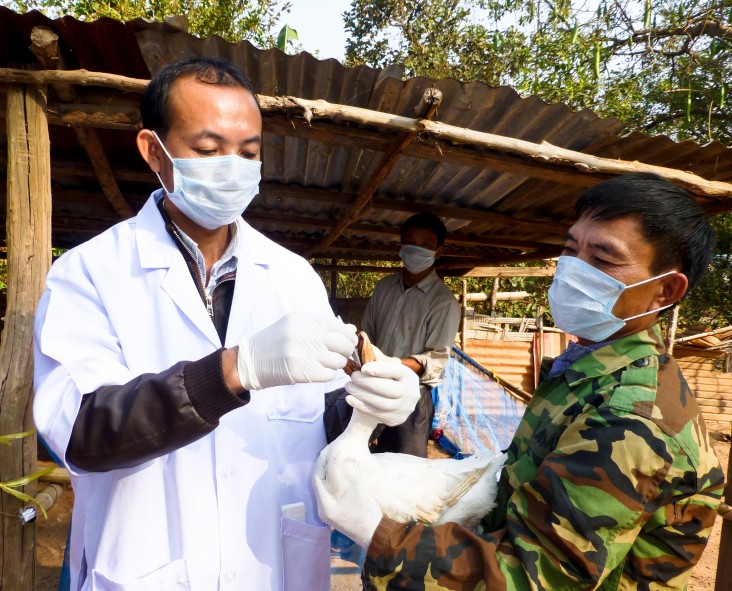
June 2015—Southeast Asia faces a disturbing set of emerging zoonoses—diseases that can be transmitted from animals to humans—capable of sparking a future pandemic, and which often circulate silently in wildlife such as bats, rodents and primates. As people move closer into the forest to live, farm and hunt, they also face greater exposure to these diseases.
All is calm and pleasant under the early morning sun on Vo Duy Ich’s poultry farm, nestled between a pond and a rice field on the outskirts of Laos’ capital, Vientiane. The tranquility is suddenly shattered by raucous squawking and flapping, however, when the farmer hops into a makeshift enclosure and lunges with mask and gloves at a duck.
Ich stretches out his prized bird toward a rubber-booted vet, who plunges a needle into the top of the duck’s head to draw blood. Putting that sample aside, he digs in his bag for two swabs and probes each end of the duck. The farmer from Vietnam’s bordering Nghe An province and his visiting veterinarian sample four other ducks in the same way. Provincial vets conducting routine surveillance have yet to detect a virus here, but they remain vigilant. With reason.
Ich lives and works at the shifting crossroads of infectious disease response in Southeast Asia that, by extension, helps prevent the rest of the world from outbreaks. With Laos—officially known as Lao People’s Democratic Republic (PDR)—sandwiched between Burma, Cambodia, China and Thailand, Ich tends to his flock in a region with high livestock mobility and high demand for poultry.
The surveillance at Ich’s farm is the first line of defense against the highly pathogenic and historically devastating avian influenza, H5N1, and a range of other zoonotic viruses such as H5N6 and H7N9. The stakes are high when it comes to people, poultry and pandemics.
USAID and its partners, including the United Nations’ Food and Agriculture Organization (FAO) and the World Health Organization, have carried out activities to help 20 countries around the world—many in South and Southeast Asia—better control outbreaks with field detection, field sampling and laboratory analysis.
“The countries have good capacity in accurate detection of influenza,” said Dr. Wantanee Kalpravkdh, regional manager of FAO’s Emergency Center for Transboundary Animal Diseases. “Most of the countries have contingency plans that function as operational manuals for outbreak response.”
Since 2009, USAID partners have taken tens of thousands of samples in Laos and other countries to test for pathogens. They also studied behavioral patterns about how communities are interacting with wildlife.
“We need smart partnerships to identify and stop diseases locally, and engage regionally across borders, before small-scale outbreaks become global crises,” said Michael Yates, director of the USAID Regional Development Mission for Asia.
For Asia’s disease crossroads countries like Laos and for farmers like Ich and their families—who stand to lose their livelihoods through culling and run the risk of infection during disease outbreaks—being vigilant means being ready for the unseen and unannounced.
Read the complete version of this story in FrontLines.
LINKS
Follow @USAIDAsia, on Facebook, on Flickr, on YouTube







Comment
Make a general inquiry or suggest an improvement.